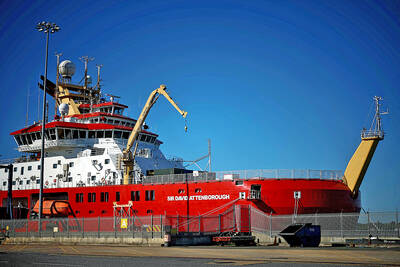A US Navy destroyer sunk during World War II and lying nearly 6,500m below sea level off the coast of the Philippines has been reached in the world’s deepest shipwreck dive, a US exploration team said.
A crewed submersible filmed, photographed and surveyed the wreckage of the USS Johnston off the coast of Samar Island during two eight-hour dives completed late last month, Texas-based undersea technology company Caladan Oceanic said.
The 115m-long ship was sunk on Oct. 25, 1944, during the Battle of Leyte Gulf as US forces fought to recover the Philippines, then a US colony, from Japanese occupation.
Its location in the Philippine Sea was discovered in 2019 by another expedition group, but most of the wreckage was beyond the reach of their remotely operated vehicle.
“Just completed the deepest wreck dive in history, to find the main wreckage of the destroyer USS Johnston,” Caladan Oceanic founder and submersible pilot Victor Vescovo wrote on Twitter. “We located the front 2/3 of the ship, upright and intact, at a depth of 6456 meters. Three of us across two dives surveyed the vessel and gave respects to her brave crew.”
Only 141 of the ship’s 327 crew members survived, US Navy records showed.
The Caladan Oceanic-backed expedition found the bow, bridge and mid-section intact with the hull number “557” still visible.
Two full five-inch gun turrets, twin torpedo racks and multiple gun mounts remain in place, it said.
Team navigator and historian Parks Stephenson said that the wreck bore the damage inflicted during the intense surface battle 76 years ago.
“It took fire from the largest warship ever constructed — the Imperial Japanese Navy battleship Yamato, and ferociously fought back,” Stephenson said.
Sonar data, imagery and field notes collected during the dives would be turned over to the US Navy, Vescovo said.

STEPPING UP: Diminished US polar science presence mean opportunities for the UK and other countries, although China or Russia might also fill that gap, a researcher said The UK’s flagship polar research vessel is to head to Antarctica next week to help advance dozens of climate change-linked science projects, as Western nations spearhead studies there while the US withdraws. The RRS Sir David Attenborough, a state-of-the-art ship named after the renowned British naturalist, would aid research on everything from “hunting underwater tsunamis” to tracking glacier melt and whale populations. Operated by the British Antarctic Survey (BAS), the country’s polar research institute, the 15,000-tonne icebreaker — boasting a helipad, and various laboratories and gadgetry — is pivotal to the UK’s efforts to assess climate change’s impact there. “The saying goes

Police in China detained dozens of pastors of one of its largest underground churches over the weekend, a church spokesperson and relatives said, in the biggest crackdown on Christians since 2018. The detentions, which come amid renewed China-US tensions after Beijing dramatically expanded rare earth export controls last week, drew condemnation from US Secretary of State Marco Rubio, who on Sunday called for the immediate release of the pastors. Pastor Jin Mingri (金明日), founder of Zion Church, an unofficial “house church” not sanctioned by the Chinese government, was detained at his home in the southern city of Beihai on Friday evening, said

TICKING CLOCK: A path to a budget agreement was still possible, the president’s office said, as a debate on reversing an increase of the pension age carries on French President Emmanuel Macron yesterday was racing to find a new prime minister within a two-day deadline after the resignation of outgoing French Prime Minister Sebastien Lecornu tipped the country deeper into political crisis. The presidency late on Wednesday said that Macron would name a new prime minister within 48 hours, indicating that the appointment would come by this evening at the latest. Lecornu told French television in an interview that he expected a new prime minister to be named — rather than early legislative elections or Macron’s resignation — to resolve the crisis. The developments were the latest twists in three tumultuous

FIRST STAGE: Hamas has agreed to release 48 Israeli hostages in exchange for 250 ‘national security prisoners’ as well as 1,700 Gazans, but has resisted calls to disarm Israel plans to destroy what remains of Hamas’ network of tunnels under Gaza, working with US approval after its hostages are freed, it said yesterday. Israeli Minister of Defense Israel Katz said that the operation would be conducted under an “international mechanism” led by the US. “Israel’s great challenge after the hostage release phase will be the destruction of all Hamas terrorist tunnels in Gaza,” Katz said. “I have ordered the army to prepare to carry out this mission,” he added. Hamas operates a network of tunnels under Gaza, allowing its fighters to operate out of sight of Israeli reconnaissance. Some have passed under